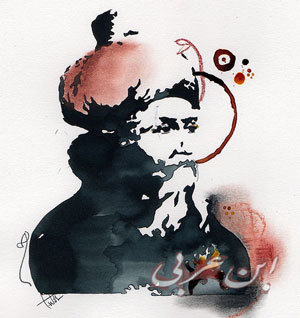“there are as many paths to god as there are souls on earth.” thus starts “bab aziz” a film by tunisian artist, writer and director nacer khemir, which explores sufism – the islam of mystics. khemir believes that sufism represents not only the tenderness of islam but also its pulsating heart. far from being a marginal phenomenon, it is the esoteric dimension of the islamic message.
abou hassan al nouri, a great sufi, once said: “sufism is the renouncement of all selfish pleasures because true love cannot be selfish. a true sufi has no possessions, and he himself is possessed by nothing.” khemir insists that “one cannot understand the aesthetics of islamic culture without studying sufi texts.”
the film follows bab aziz, an old sufi, and his granddaughter as they travel through the desert on a quest to find a gathering of dervishes that only takes place once every 30 years. they find many fellow travelers on this journey. everyone has their own story, their own gift, their own holy grail. each must find his or her own path. “he who has faith never gets lost,” bab aziz reminds them. yet whether they’re in search of a lost love, a dream palace, or god himself, the characters and their stories are partly steeped in melancholy. there is this sense of the human search for something ephemeral, something unattainable which slips through one’s fingers like fine desert sand. this gentle sense of disquiet builds up throughout the film and reaches a climax at the end. as bab aziz prepares for his own death, he comforts hassan, a young man who finds death disturbing, with some of the most brilliant, satisfying words in the film:
bab aziz: if the baby in the darkness of its mother’s womb were told, “outside there’s a world of light, with high mountains, great seas, undulating plains, beautiful gardens in blossom, brooks, a sky full of stars and a blazing sun. and you refuse all these marvels and stay enclosed in this darkness.” the unborn child, knowing nothing about these marvels, wouldn’t believe any of it. like us when we’re facing death. that’s why we’re afraid.
hassan: but there can’t be light in death because it’s the end of everything.
bab aziz: how can death be the end of something that doesn’t have a beginning? don’t be sad on my wedding night.
hassan: your wedding night?
bab aziz: yes, my marriage with eternity.
the complementary title of “the prince who contemplated his soul” comes from a ceramic plate painted in 12th century iran with the exact same inscription. according to an afghan fable, a handsome prince left his throne to sit day and night by a small pool of water. people said: “you’d think he’s looking at his reflection in the water.” but a dervish explained to them: “maybe it’s not his image. only those who are not in love see their own reflection. he’s contemplating his soul, don’t wake him, it might take wing.”
shot beautifully in both the iranian central desert and in the tunisian desert in tataouine, the film brings together actors from iran, iraq, tunisia, kurdistan, and algeria. the musical score is equally rich and diverse. khemir explains: “in arab culture, poetry’s raison d’être is singing. songs and music create ambivalence between presence and absence, the visible and the invisible, reality and mystery. mysticism runs through both the popular and scholarly traditions of arab, persian and turkish cultures. the “baraka” (the blessing) springs out of this mystic voice. it envelops and permeates humans, places, objects. vocal music is often accompanied by dance, as in the performances of whirling dervishes who dance with one hand directed towards the sky, in order to receive the divine blessing, and the other hand directed towards the earth, to transmit this blessing to the audience. these sacred and popular types of music convey an extraordinary vitality and a communicative joy from asia to africa, from the arab world to the persian world. they guarantee a cohesion that asserts its unity and its desire for life.”
bab aziz is more of an audio-visual allegory than a linear story. khemir encourages the viewer to put aside his or her ego and open up to the world. the film “borrows the structure of the visions narrated by dervishes and the structure of their spiraling, whirling dances. characters change but the theme remains the same: love in its many forms.” in the words of the famous sufi ibn arabi:
my heart can take many shapes:
for a monk it becomes a monastery, for idols – a temple,
for gazelles – a pasture, for the faithful – kaaba.
it can become a roll of the torah or the koran.
my belief is love; wherever its caravan might lead me,
love remains my religion and belief…



